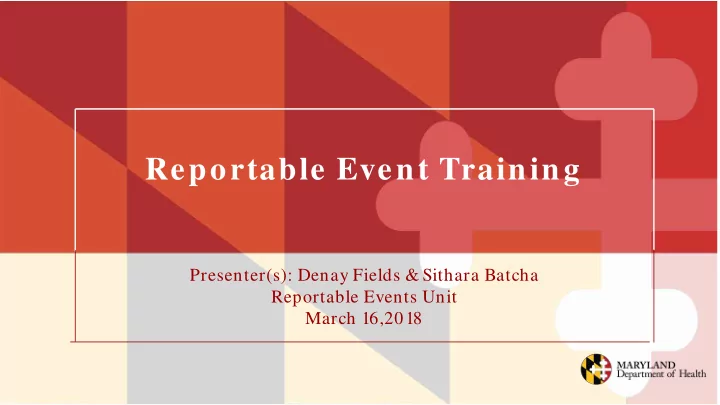

Reportable Event Training Presenter(s): Denay Fields & Sithara Batcha Reportable Events Unit March 16,2018
Overview The purpose of the Reportable Events Unit is to ensure the health, safety, and welfare of participants in home and community based services. • Ensure participants, families, representatives or providers are involved in identification of Reportable Events and Interventions that promote participants maximum health, safety, independence and choice • The Department assures CMS necessary safeguards are in place to protect the health and welfare of program participants. • Provide accurate documentation and Performance Measurements for Health and Welfare Assurances.
Reportable Events Tracking System ➤ LTSSMaryland is an electronic tracking system in which Reportable Events are submitted. ➤ Supports Planners are required to submit in LTSSMaryland tracking system a Reportable Event received in any form(email, telephone, paper Reportable Event form, etc.) ➤ Nurse Monitors can also submit Reportable Events but it is the Support Planners role to follow up with participant and submit the intervention and action plan if not completed.
Reportable Event Review Process ➤ Provide Oversight and Monitoring ● Partner entities have appropriately addressed the RE situation. ● The participant’s safety following an event has been secured. ● Appropriate documentation is maintained on the event so State can meet Federal reporting requirements. ● Prevention and Corrective Action Plans have been properly addressed.
Reportable Event Review Process ➤ Data Collection •Assure accuracy and validity of data reported. •Analyze trends and need for quality improvement in HCBS programs. ➤ Quality Assurance •Health, safety and welfare of participants are maintained. •Participant rights and choices are safeguarded. •Reports are submitted within policy timelines for review and intervention.
Incident Types Abuse Neglect Accident/Injury (Wound, Fracture, Etc.) ER Visits Death/suicide/suicide/attempts Abandonment, Missing Person Rights Violations Medication or treatment error .
Complaint Types Examples of Complaints Not Complaints Participant complaint regarding attendant care Provider complaining of not getting paid. Participant complaint regarding access to Reporting duplicate information already on Medicaid providers. form(ER visits, hospital stay) Participant complaint regarding service issues. NM complaint about the RSA not seeing participant. (Other) Representative complaint if participant not able to voice complaint due diagnosis or cognitive SP complains of the odor in the house but level. participant doesn’t
Imagine This... You get a call from your child’s school. The operator says “Your son fell on the playground” and then hangs up the phone. What are some things you need to know?
Reportable Event Form
Incident Types
Description of Event(s)
Reportable Event Timeframes 10 Days After Notification and Knowledge of the E vent. The Intervention and Action Plan is due in LTSS!!
Intervention and Action Plans
Example 1: Fall - Event Report
Example 1: Fall - IAP Client attending physical therapy twice a week. POS revised to obtain a shower chair for client. Caregiver to observe client while he showers to make sure he doesn’t fall.
Example 2: Wound, Event Report Provides a snapshot of the client with important and relevant details.
Example 2: Wound - IAP Skilled Nursing Care, Ensure Services Resume, Follow-up.
Coordination of Care ➤ Ensuring the participants health, safety and welfare. ➤ Each entity is required to report when knowledge is discovered. ( NM and SP) ➤ Nurse monitors, Assessors, Support Planners must share information ➤ Providers are required to report to Support Planners. ➤ MDH is responsible for oversight and monitoring responsibility ➤ All entities should work together to ensure accurate information is reported and appropriate intervention is addressed in timely manners.
Coordination with Nurse Monitors ● Nurse Monitors are partners in ensuring client health and welfare. ● Must contact (by phone or email) Nurse Monitor for critical medical issues. ○ Immediately upon submission of RE. Provide regular updates. ○ Examples: Death, wounds, serious hospitalizations (ICU, Sepsis) ● If a Nurse Monitor enters an RE, it is the Support Planners role to follow up with participant and submit the Intervention and Action Plan. ● Reminder: ask about Reportable Events in every SP monthly contact; ○ Nurse Monitors have less frequent client contacts than Support Planners, but Nurse Monitors often hear from clients about hospitalizations, ER visits, etc, but find no REs in LTSS. ● Ensure Nurse Monitors can view Progress Notes.
Reportable Event Timeframes
Make A Difference! Color My World-Youtube
Questions
Recommend
More recommend